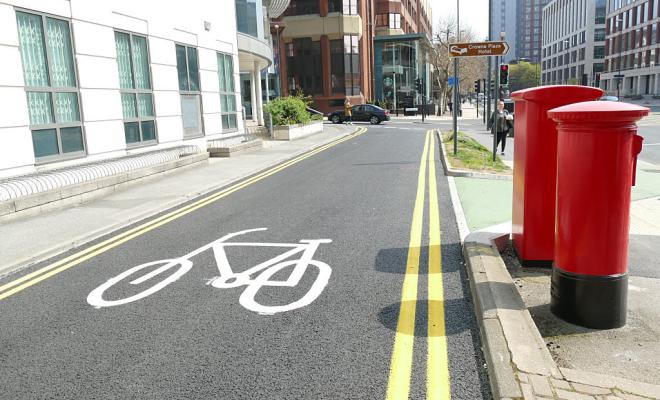25 Sep 2024
Councils, climate and raising money
As campaigners, we need to understand that councils are struggling with stretched budgets following a decade of cuts, exacerbated by the COVID-19 pandemic and rising energy prices. In addition, funding that’s been made available by national government for local climate action has been too fragmented, complicated, and often in the form of competitive grants. This has hindered councils’ ability to set out long-term plans, including for building the skills and capacity they need. While lack of money can sometimes be an excuse for inaction, a lack of staff, expertise and finances hinders action on climate and nature restoration, even when there's political will.
However, there are ways that councils can raise funds for climate action. The good news is that some of the actions councils can take to tackle the climate crisis will also bring in money. For example, councils can introduce a workplace car parking levy or similar initiatives to fund and encourage sustainable transport, particularly measures that allow people to travel safely to work, such as segregated cycle ways. Councils can also introduce a congestion charge or Clean Air Zone and use the money to fund public transport.
Some actions can be made cost neutral for councils. For example, fees for the licencing of private-rented sector housing can cover the enforcement costs of ensuring compliance with Minimum Energy Efficiency Standards. Councils can also make money from renewable energy generation, although this does require significant investment initially.
Councils can raise money using bonds for low-carbon infrastructure, including energy efficiency measures, renewable energy and new public green space. One example is Community Municipal Investments, which allow residents to support low-carbon projects in their community.
Money to fund climate action and nature restoration projects can be brought in via legal and planning mechanisms, such as Section 106 agreements or the Community Infrastructure Levy (CIL). Section 106 agreements are when a local authority approves a development, such as new homes, based on the requirement that the developer also funds other related projects. The CIL is a charge that can be levied on new developments, which can help local authorities to deliver other infrastructure needed in their area. Councils should be using the CIL to fund carbon-cutting projects like active travel infrastructure and new green space, but it’s worth noting that a replacement Infrastructure Levy has been proposed (see “Challenges” below).
The new, government-owned Infrastructure Bank will also be a potential source of loans for local authorities to fund climate action. The bank will initially partner with Bristol, Greater Manchester and West Yorkshire on 3 pilot projects that’ll focus on net zero and local growth: the electrification of buses, mass transit (such as trams) and low-carbon energy infrastructure.
The target
In recognition of the funding cuts that councils have faced in recent years, a reasonable goal for councils to aim for is:
To have sufficient resources to invest in the changes needed to restore nature and meet climate goals, so that the council can reap the dividends and deliver its fair share of reduction in greenhouse gas emissions.
Councils leading the way
Some councils are already making strides towards raising funds for climate action. Share these examples with your council using this template email and help inspire them to take action.
Warrington Borough Council has used community municipal bonds to fund renewable energy projects. Bonds are issued to members of the public for as little as £5 via an online platform. Through this scheme, Warrington raised £1 million, which it invested in a solar farm. The revenue from the solar farm will be used to help reduce fuel poverty by contributing towards the council’s own fuel poverty charity, the Warrington Community Energy Trust. The charity is also benefiting from interest payments that investors have chosen to donate back to the council. The council says that residents are positive about the scheme and have become more engaged in its wider plans to tackle climate change.
Nottingham City Council has used a workplace parking levy to limit congestion, cut emissions and raise millions of pounds to help fund high-quality public transport networks. In Nottingham, the charge only applies to employers who provide 11 or more parking spaces. Smaller employers are exempt, as are spaces for disabled people, NHS premises and emergency services. Nottingham has raised £83 million directly from the levy, which has enabled an extension to its tram system.
South Gloucestershire Council is using its CIL to fund the authority’s climate emergency infrastructure budget. The decision to use the CIL for climate funding was approved in February 2020 and will amount to £1.5 million a year until at least 2024. This amount will be split equally across 3 focus areas: green schools, green transport and green communities.
Liverpool City Council is using a licencing scheme to improve the condition of rented properties in parts of the city where home energy efficiency is at its worst. The maximum licence fee is £570 per property, with new landlords or landlords accessing an early bird rate paying a discounted fee of £400 per property, as well as a further reduction for properties with a high energy efficiency rating (Energy Performance Certificate of C+). These fees mean that the enforcement of energy efficiency standards in licenced areas will be cost neutral for the council.
Cambridgeshire County Council is investing in solar farms. Its first solar farm, Triangle Solar Farm, currently raises a net revenue of £350,000 per year for the council, after debt charges on its capital borrowing. Once the original loan used to finance the farm is paid off, annual revenue will increase to £1 million. The money has been used to part-fund adult social care services, including buying equipment and technology to support elderly people living independently.
Challenges
Given the financial situation councils find themselves in, it can seem surprising that they aren’t all rushing to introduce innovative fundraising schemes like local climate bonds. But councils, especially their finance teams, can be wary of new ways of raising money due to unfamiliarity and perceived risks.
Some ways of raising money locally can be controversial. Nottingham City Council had to overcome a lot of local concern about the impact on workers when it planned the introduction of a workplace parking levy (see above), and a similar levy was proposed but not taken forward in Leicester due to the high level of opposition. It’s important for councils to learn from each other to overcome barriers and address local concerns. For example, a parking levy can be adjusted to ensure that only larger companies contribute, and some employees can be exempted or offered discounted parking spaces to make sure it’s applied fairly.
Established ways of making money can also change, creating uncertainty about the future potential to raise funds for climate action. For example, some councils like South Gloucestershire (see above) use the CIL to raise money for carbon-cutting infrastructure, but this is going to be replaced by a new Infrastructure Levy.
The powers available to UK local authorities are still limited compared with some other countries. These could usefully be expanded to help them raise more money (see “Funding and powers” below). For example, a recent study by the Northern Powerhouse Partnership concluded that introducing a £1 tourism levy across England would raise £428 million for local authorities annually. The Welsh Government is already considering granting powers to its councils to do this.
Devolution deals are starting to support more local fundraising. For example, the new “trailblazer” devolution deals for the West Midlands and Greater Manchester allow the mayors to retain 100% of business rates. But until climate and nature are put at the heart of such deals, the money won’t necessarily be spent on environmental measures.
Convince your council
The best way you can convince your council to take action on climate is to show that you have the support of your community behind you. Your power comes from showing that you’re not alone. Make your campaign diverse, stronger and more impactful by building alliances with others.
For councils, demonstrating good engagement with community partners can help them access money to make progress on their climate ambitions. Working with various local authorities, our group Hope Valley Climate Action was instrumental in securing £120,000 from the Department for Transport. These funds were used for a range of climate action projects aimed at tackling rural transport emissions, known as the “Travelling Light” programme. It’s now being taken forward in partnership with the local authorities and transport operators.
It’s helpful to be able to show councils successful outcomes like this and the ones outlined above (see “Councils leading the way”). The Green Finance Institute also has various examples of councils pioneering local climate bonds.
Councils are more amenable to introducing schemes that have a wide array of benefits, as it means they’re more cost effective. Raising money for schemes that deliver across several of the council’s aims makes sense in the current economic climate. For example, Liverpool’s licencing scheme will create healthier, warmer homes as well as cutting carbon emissions, while Cambridgeshire’s solar farms are generating clean electricity, cutting emissions and raising funds for social care at the same time (see above).
Funding and powers
Action by national governments will empower councils to do more. Councils can and are acting now, but it’s hard to find a council able to act across all the areas they need to and at the scale and pace commensurate to the climate and ecological emergencies. That’s why they need additional powers and resources. Central government can help by:
- Ensuring that its plans to devolve more powers and funding to local authorities are aligned with legally binding climate targets and budgets. All future devolution deals need to include ambitious plans for local actions to reduce carbon emissions, adapt to the impacts of climate change, and restore nature.
- Granting local authorities more powers to raise funds as they have in other countries. For example, payroll levies in France help to pay for public transport, while in Switzerland tourist levies help to provide free public transport journeys for visitors. In the UK, Manchester has introduced a “tourist tax,” but this had to be achieved through voluntary arrangements with hotel businesses.
- Replacing short-term, competitive funding for local climate and nature action with adequate, long-term funding, giving local authorities the flexibility they need to target spending locally. Research shows that a place-specific approach is a much more cost-effective way to meet the targets of the sixth carbon budget than a more centralised approach.
Friends of the Earth has joined local government organisations, academics and other NGOs in setting out a Blueprint of what’s needed from national government to support councils in key policy areas, including raising funds for climate action. The coalition has assessed how the government is doing so far in its progress tracker. Be sure to ask your council to sign up to the Blueprint if it hasn't done so already.
Helpful resources
Watch our training video and learn how your council can raise money to fund climate action:
Find out how you can build a strong campaign to push your council to take ambitious action in this area.
Get to grips with how your council works.
Read more examples of best practice by councils.
Find out how your council is doing by looking at its Council Climate Action Scorecard, created by Climate Emergency UK.
See additional ways in which councils can raise money, as identified by the Centre for Cities and the Joseph Rowntree Foundation.
See more information on local climate bonds, including which councils have pledged to introduce a climate bond scheme.
See more information on powers available to local authorities to raise money for public transport.
Find out what progress your local area has already made on climate action with our handy data tool, “Near you”.
Any references to national policy in this guide relate to policy under the previous government and reflect the policy context at the time it was written.



